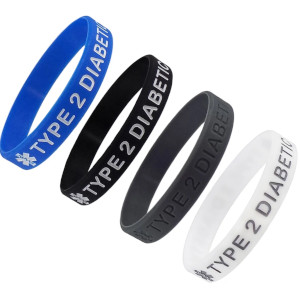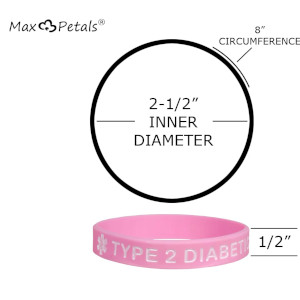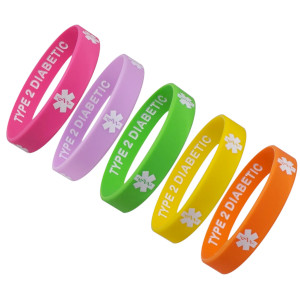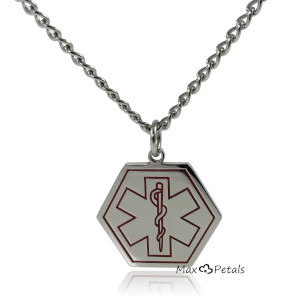Why Type 2 Diabetics Need Medical IDs
Type 2 diabetes can present unique challenges during medical emergencies. If you take medications that can cause hypoglycemia, such as insulin or sulfonylureas, or if you have other health complications, first responders need to know about your condition immediately—even if you can't tell them yourself.
A Type 2 diabetes medical ID provides critical information to emergency personnel, potentially preventing harmful treatment delays and ensuring you receive the proper care. The American Diabetes Association recommends that all people with diabetes wear medical identification, especially those taking insulin or medications that can cause low blood sugar.

Type 2 Diabetes Medical Alert Bracelets & Necklaces

Type 2 Diabetic Medical Alert Bracelets (5-Pack)
Privacy-enhanced silicone wristbands with clear Type 2 diabetes medical information.

TYPE 2 DIABETIC Medical Alert ID Bracelets (4-Pack)
Comfortable silicone bracelets in classic colors that clearly identify Type 2 diabetes.

TYPE 2 DIABETIC Medical Alert Bracelets - Pastels (4-Pack)
Soft pastel colors with clear Type 2 diabetes medical information for a more subtle style.

TYPE 2 DIABETIC Silicone Wristbands - Fun Colors (5-Pack)
Vibrant, privacy-enhanced silicone bracelets for a more personal style with the same safety features.

"TYPE 2 DIABETES" Adjustable Medical Alert Wristband
Comfortable, adjustable wristband that provides clear medical information with a secure fit.

Type 2 Diabetes Medical Alert ID Pendant Necklace
Stainless steel pendant with 26" chain, durable and water-resistant for everyday wear.
Type 2 Diabetes Medical ID Guidelines
Essential Information to Include
- Name (first name, at minimum)
- "Type 2 Diabetes" or "T2D"
- Medication type (insulin, oral meds)
- Emergency contact number
- Any severe allergies
Important Considerations for Type 2
- Specify if you take insulin
- List medications that can cause hypoglycemia
- Note any heart conditions or kidney issues
- Include blood thinner information if applicable
- Note metformin use if you undergo imaging tests
Choosing the Right Type 2 Medical ID
- Comfortable enough for daily wear
- Durable for your lifestyle
- Clear, legible text that won't fade
- Consider water-resistance for active lifestyles
- Style that matches your preferences
Special Considerations for Type 2 Diabetes
Understanding the Different Emergency Risks
Type 2 diabetes presents unique emergency considerations that may differ from Type 1. While hypoglycemia (low blood sugar) is a concern for those on insulin or certain medications, people with Type 2 diabetes are also at increased risk for other complications that should be considered in emergency situations.
Heart disease, stroke, and certain medication interactions are more common in Type 2 diabetes. Your medical ID can help emergency responders understand your specific situation and provide appropriate care, especially if you have other health conditions alongside your diabetes.
Medication Information on Your ID
Not all Type 2 diabetes treatments carry the same risks in emergency situations. If you take medications that can cause hypoglycemia, such as sulfonylureas (like glipizide or glyburide) or insulin, it's important that this information is available to first responders.
Additionally, if you take metformin, this should be noted for situations where contrast dyes might be used for imaging tests, as temporary discontinuation may be necessary. Including a note about blood thinners can also be critical in trauma situations where bleeding is a concern.
Common Emergency Scenarios for Type 2 Diabetes
Hypoglycemia
If you take insulin or medications that lower blood sugar, hypoglycemia can cause confusion, dizziness, or loss of consciousness. A medical ID alerts responders to check your blood sugar immediately.
Cardiovascular Events
People with Type 2 diabetes have increased risk of heart attack and stroke. A medical ID helps emergency teams understand the underlying condition that may complicate treatment.
Severe Hyperglycemia
Very high blood sugar can lead to Hyperosmolar Hyperglycemic State (HHS), causing severe dehydration and confusion. Your medical ID alerts responders to this possibility.
Accidents or Trauma
Physical trauma can affect blood sugar levels and healing. Emergency responders need to know about your diabetes when treating injuries or preparing for surgery.
Expert Advice for Type 2 Diabetes Medical IDs
"Many of my Type 2 diabetes patients don't realize they should wear medical IDs, especially if they're not on insulin. But even oral medications can cause dangerous low blood sugar episodes, particularly in stressful situations like accidents or during illnesses."
— Dr. Michael Chen, Endocrinologist
Tips From Diabetes Educators
- Specify your medication regimen. Note whether you take insulin, oral medications, or both.
- Include information about other conditions. Many Type 2 patients have additional health concerns that are relevant in emergencies.
- Update your ID if your treatment changes. If you start insulin therapy or new medications, your medical ID information should be updated.
- Consider multiple IDs. Many patients benefit from having both a bracelet and a necklace to ensure visibility in any situation.
- Include A1C information only if extreme. Very high A1C levels might be relevant for emergency responders.
Frequently Asked Questions About Type 2 Diabetes Medical IDs
Do I need a medical ID if I only take oral medications for Type 2 diabetes?
Yes, many healthcare professionals recommend that all people with diabetes wear medical IDs, regardless of medication type. Some oral medications, particularly sulfonylureas like glipizide or glyburide, can cause hypoglycemia (low blood sugar) which may require immediate attention. Additionally, your diabetes status is important information for emergency responders even if you're being treated for an unrelated condition or injury.
What's the difference between Type 1 and Type 2 diabetes medical IDs?
The main difference is in the specific information provided. Type 1 diabetes medical IDs typically emphasize insulin dependency, as all Type 1 diabetics require insulin. Type 2 diabetes medical IDs may specify the type of treatment (oral medications, insulin, or both) since treatment varies more widely among Type 2 patients. The physical products themselves are similar in quality and appearance, with clear labeling of the specific diabetes type.
How do first responders use the information on my Type 2 diabetes medical ID?
Emergency responders are trained to look for medical IDs when evaluating patients, especially those who are unconscious or unable to communicate. When they see you have Type 2 diabetes, they may check your blood glucose levels more promptly and consider how your diabetes might be affecting your current situation. If you're experiencing confusion or unconsciousness, they'll consider whether hypoglycemia might be the cause, particularly if your ID indicates you take insulin or sulfonylureas. This information helps them provide the most appropriate treatment quickly.
Are silicone medical ID bracelets durable enough for daily wear?
Yes, our silicone Type 2 diabetes medical ID bracelets are designed for durability and everyday use. They're waterproof, sweatproof, and resistant to fading with normal wear. Many customers report their silicone bracelets lasting for years. The embossed text ensures the critical medical information remains legible even with regular exposure to water, soaps, and hand sanitizers. For those with more active lifestyles or who work with their hands, silicone bracelets often provide the best combination of durability and comfort.
Protect Yourself with a Type 2 Diabetes Medical ID
A medical ID could make all the difference in an emergency situation.
